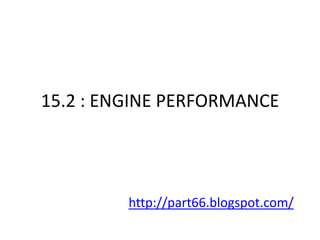
Engine Performance Factors
- 1. 15.2 : ENGINE PERFORMANCE http://part66.blogspot.com/
- 2. THRUST • Gross Thrust = Total thrust = Momentum Thrust by engine(F=ma) • Net Thrust = Gross thrust – momentum drag(flying speed) = mv2 – mv1 • Chocked Nozzle Thrust = Pressure thrust(venturi) = P2 – P1(area nozle) • Resultant Thrust = Net Thrust = Mom thrust + Mom drag + Prss thrust
- 3. THRUST DISTRIBUTION • Distribution of thrust vary in every section of engine. • It can be calculated base on exit duct area(A), exit presssure(P), exit air velocity(v) and air mass flow(w) • Thrust Load(sect2) = ((AxP) + WV/g) – thrust load(sect1) • Value is (+ve) for convergence exit and (-ve) for divergence exit • Resultance thrust is sum of all trust load in every section.
- 4. HORSE POWER • 1HP = 746watt • Thrust Horse Power(jet engine): THP = Thrust(Ib) x Aircraft speed(ft/s) 550ft/s • Actual horsepower engine-propeller unit found less compare to jet engine • Equivalent Shaft Horse Power(turboshaft engine): ESHP = SHP + (jet thrust ÷ 2.5)
- 5. SPECIFIC FUEL CONSUMPTION • Amount of fuel required in a time to produce specific thrust output • Normallt compare during cruise condition
- 6. ENGINE EFFICIENCIES • Thermal efficiencies : KE ÷ Fuel Energy Ratio of convertion of heat energy to kinetic energy (thrust) • Propulsive efficiencies : _________Work done____________ Work done + Work wasted in exhaust Ratio of convertion of kinetic energy(thurst) to do the work(pushing aircraft) • Overall efficiency : TE + PE
- 7. RATIO • By-pass ratio is a ratio mass of air bypasses engine core and air passing through the engine core. • Engine pressure ratio is ratio between Turbine exit pressure to the engine intake pressure By-pass air EPR = P(intake) P(exhaust) P(exhaust) P(intake)
- 8. PERFORMANCE GRAPH Velocity Pressure Temperature Peak velocity at begining of turbine inlet Peak pressure at the end of compressor section Peak temp at begining of combustion chamber
- 9. FACTOR EFFECTING THRUST • Temperature : Thrust increase with decreasing in temperature (air density increase at low temp) • Air Pressure : Thrust increase with increasing air pressure (air density increase by pressure) • Altitude : Thrust decrease with increase in altitude (change rate after 36kft = temp constant) • Airspeed : Thrust decrease initially then increase back due to ram air effect on jet engine